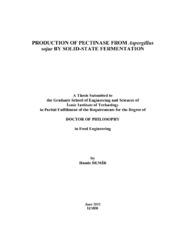Please use this identifier to cite or link to this item:
https://hdl.handle.net/11147/2933Full metadata record
| DC Field | Value | Language |
|---|---|---|
| dc.contributor.advisor | Tari, Canan | en |
| dc.contributor.author | Demir, Hande | - |
| dc.date.accessioned | 2014-07-22T13:48:37Z | |
| dc.date.available | 2014-07-22T13:48:37Z | |
| dc.date.issued | 2012 | en |
| dc.identifier.uri | http://hdl.handle.net/11147/2933 | |
| dc.description | Thesis (Doctoral)--Izmir Institute of Technology, Food Engineering, Izmir, 2012 | en |
| dc.description | Includes bibliographical references (leaves: 173-187) | en |
| dc.description | Text in English; Abstract: Turkish and English | en |
| dc.description | xviii, 187 leaves | en |
| dc.description.abstract | Pectinases are one of the most important enzyme groups that have wide applications in the food industry, especially the fruit juice industry. The production of polygalacturonase from agro-industrial residues by solid-state fermentation leads to not only the acquisition of a value-added product but also the solution of pollution problem caused by the disposal of these residues. In the scope of this study, the production of polygalacturonase from novel mutant Aspergillus sojae strains by using solid-state fermentation techniques was investigated. The effects of orange peel concentration, incubation temperature and time, inoculation size and HCl concentration on polygalacturonase activity and spore production from Aspergillus sojae M3 were investigated with experimental design and statistical analysis. Various agro-industrial residues and A. sojae strains were screened for the production of polygalacturonase and, wheat bran and Aspergillus sojae M5/6 pair was selected as the substrate – strain pair. The optimum fermentation conditions for the flask scale production were found as 107 spore/g substrate inoculum size, 4 days, 37 °C, 62% initial moisture content, neutral pH, 150-250 μm particle size, 3 times/day agitation frequency and spore inoculum type. The maximum polygalacturonase activity (535.4 U/g substrate) obtained in this study was very competitive with the ones reported in the literature. In contrast to other studies in the literature, high polygalacturonase activity was achieved using wheat bran without the addition of any supplementary nutrients that could increase the cost of the production process. The production of PG from Aspergillus sojae M5/6 in the tray and bioreactor scales we also performed. | en |
| dc.language.iso | en | en_US |
| dc.publisher | Izmir Institute of Technology | en |
| dc.publisher | Izmir Institute of Technology | en_US |
| dc.rights | info:eu-repo/semantics/openAccess | en_US |
| dc.subject.lcsh | Solid-state fermentation | en |
| dc.subject.lcsh | Polygalacturonase | en |
| dc.subject.lcsh | Aspergillus | en |
| dc.title | Production of pectinase from aspergillus sojae by solid-state fermentation | en_US |
| dc.type | Doctoral Thesis | en_US |
| dc.authorid | TR130577 | |
| dc.institutionauthor | Demir, Hande | - |
| dc.department | Thesis (Doctoral)--İzmir Institute of Technology, Food Engineering | en_US |
| dc.relation.publicationcategory | Tez | en_US |
| item.fulltext | With Fulltext | - |
| item.grantfulltext | open | - |
| item.languageiso639-1 | en | - |
| item.openairecristype | http://purl.org/coar/resource_type/c_18cf | - |
| item.cerifentitytype | Publications | - |
| item.openairetype | Doctoral Thesis | - |
| Appears in Collections: | Phd Degree / Doktora | |
Files in This Item:
| File | Description | Size | Format | |
|---|---|---|---|---|
| T001027.pdf | DoctoralThesis | 3.21 MB | Adobe PDF |  View/Open |
CORE Recommender
Page view(s)
156
checked on Nov 18, 2024
Download(s)
192
checked on Nov 18, 2024
Google ScholarTM
Check
Items in GCRIS Repository are protected by copyright, with all rights reserved, unless otherwise indicated.